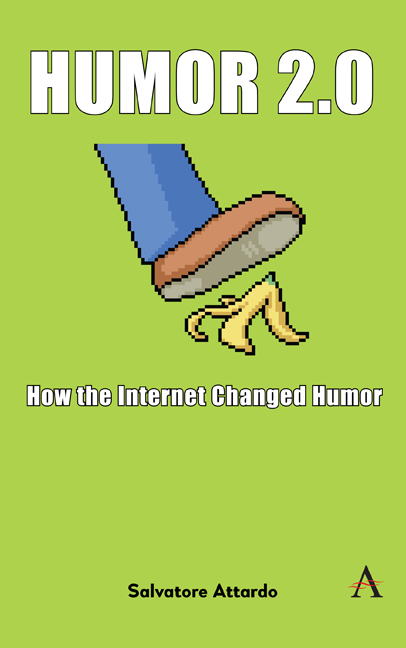1 - Humor and the Internet
Published online by Cambridge University Press: 28 February 2024
Summary
The Internet (Web 1.0)
This is not a historical study, but it is important to start by noting that our world has changed significantly in an astonishingly short time span. Thirty years ago, this book would have been inconceivable simply because none of its subject matter existed. It is easy to forget that the changes we will consider all happened in under 30 years, and often much less.
The Internet was invented in 1989 by Tim Berners-Lee at CERN (Conseil Européen pour la Recherche Nucléaire) in Geneva, Switzerland. What Berners-Lee came up with was a transfer protocol (set of instructions) called HTTP (Hypertext Transfer Protocol) which was itself based on the older FTP (File Transfer Protocol) dating back to 1971. Berners-Lee also wrote the first browser, called WWW (World Wide Web [1990]) which allowed people to interact easily with files. Part of the development of HTTP and WWW involved laying the foundations of HTML, the code that tells browsers what to display on screen. WWW was followed by Mosaic (1993), Netscape (1994) and Internet Explorer (1995). Later, Netscape launched Mozilla (1998) as open source.
While originally meant as a decentralized network for military operations and after its adoption by academe as a way to transfer files and information about research, almost immediately the internet started being used as a way to socialize, much along the line of the first 1980s Bulletin board systems (BBSs: Fidonet, The WELL, etc.). BBSs were essentially a precursor of the internet, with the difference that they worked over phone lines and had a dial-up model (where a user would connect to the BBS, get their email or download news and log off to read them offline). Importantly the idea was to use a local BBS so that one would not have to make a long distance call, which at the time were much more expensive than local calls.
Usenet: The Big Eight and the alt. Hierarchy
BBSs “evolved” into usenet, which was decentralized; in other words, there was no need to call a central BBS. News, posts and discussions could be accessed from any computer on the network. Usenet was organized in a hierarchy of newsgroups (discussion boards) where users could post. For example the rec groups (rec stands for recreation) include rec.music, rec.film and others.
- Type
- Chapter
- Information
- Humor 2.0How the Internet Changed Humor, pp. 7 - 22Publisher: Anthem PressPrint publication year: 2023



